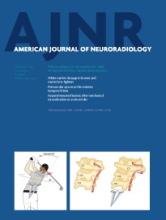Research ArticlePediatric Neuroimaging
Bannayan-Riley-Ruvalcaba Syndrome: MRI Neuroimaging Features in a Series of 7 Patients
R. Bhargava, K.J. Au Yong and N. Leonard
American Journal of Neuroradiology February 2014, 35 (2) 402-406; DOI: https://doi.org/10.3174/ajnr.A3680
R. Bhargava
aFrom the Departments of Radiology and Diagnostic Imaging (R.B.)
K.J. Au Yong
cDepartment of Radiology and Diagnostic Imaging (K.J.A.), McMaster University Medical Centre, McMaster Children's Hospital, Hamilton, Ontario, Canada.
N. Leonard
bMedical Genetics (N.L.), University of Alberta Hospital, Edmonton, Alberta, Canada

References
- 1.↵
- Fargnoli MC,
- Orlow SJ,
- Semel-Concepcion J,
- et al
- 2.↵
- Zbuk KM,
- Eng C
- 3.↵
- 4.↵
- Marsh DJ,
- Kum JB,
- Lunetta KL,
- et al
- 5.↵
- Parisi MA,
- Dinulos MB,
- Leppig KA,
- et al
- 6.↵
- Eng C
- 7.↵
- Hobert JA,
- Eng C
- 8.↵
- Lachlan KL,
- Lucassen AM,
- Bunyan D,
- et al
- 9.↵
- Wanner M,
- Celebi JT,
- Peacocke M
- 10.↵
- Srinivasa RN,
- Burrows PE
- 11.↵
- Nebgen S,
- Zerres K,
- Deutz U,
- et al
- 12.↵
- 13.↵
- 14.↵
- Lok C,
- Viseux V,
- Avril MF,
- et al
- 15.↵
- Butler MG,
- Dasouki MJ,
- Zhou XP,
- et al
- 16.↵
- Conti S,
- Condò M,
- Posar A,
- et al
- 17.↵
- DiLiberti JH,
- D'Agostino AN,
- Ruvalcaba RH,
- et al
- 18.↵
- 19.↵
- Wang SI,
- Puc J,
- Li J,
- et al
- 20.↵
- 21.↵
- Hamada K,
- Sasaki T,
- Koni PA,
- et al
- 22.↵
- 23.↵
- Tan WH,
- Baris HN,
- Burrows PE,
- et al
- 24.↵
- Merks JH,
- de Vries LS,
- Zhou XP,
- et al
- 25.↵
- Schaefer GB,
- Bodensteiner JB,
- Buehler BA,
- et al
- 26.↵
- 27.↵
- 28.↵
- Batla A,
- Pandey S,
- Nehru R
In this issue
American Journal of Neuroradiology
Vol. 35, Issue 2
1 Feb 2014
Advertisement
R. Bhargava, K.J. Au Yong, N. Leonard
Bannayan-Riley-Ruvalcaba Syndrome: MRI Neuroimaging Features in a Series of 7 Patients
American Journal of Neuroradiology Feb 2014, 35 (2) 402-406; DOI: 10.3174/ajnr.A3680
0 Responses
Jump to section
Related Articles
- No related articles found.
Cited By...
- No citing articles found.
This article has not yet been cited by articles in journals that are participating in Crossref Cited-by Linking.
More in this TOC Section
Similar Articles
Advertisement











